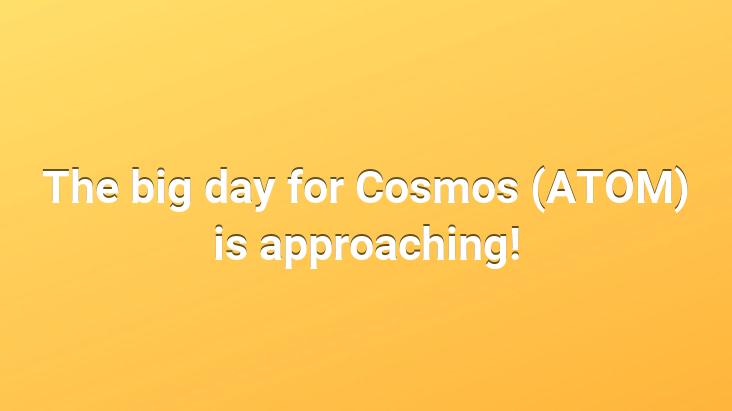Cosmos (ATOM) is counting the days for its Stargate update. Cosmos is developing communication (IBC) protocols for its own blockchain.
The big day is approaching for Cosmos (ATOM)!
Bitcoin 50 It has exceeded a thousand dollars and there are serious movements in altcoins.. One group in particular is working hard to solve the scaling and speed issues of cryptocurrencies.. Cryptocurrencies that solve the scaling problem get their money’s worth.. We can give Cardano (ADA) as an example.. Working for the Shelley update throughout 2020, Cardano began to reap the fruits of these efforts in 2021, and the ADA/USD parity is running towards $1.
Other noteworthy update works; What happens in the Ethereum, Cosmos, Polkadot and Tron ecosystems. The scaled and fast blockchain network is now essential for Ethereum. Gas prices of the overly concentrated Ethereum blockchain skyrocket. The operating cost of transfer transactions on the Ethereum blockchain fluctuates between $ 15-30. The high operating fee causes Ethereum to lose its competitiveness.
As Ethereum loses its competitiveness, the day is dawning for other blockchains. Cardano, Cosmos and Polkadot seem ready to snatch the capital fleeing Ethereum.
Please See: Ethereum news, agenda and breaking news
Cosmos has renamed Stargate counting the days for his update. Cosmos develops communication (IBC) protocols for its blockchain. Thanks to this protocol, Cosmos will be able to securely and quickly flow data and funds between projects traded on its own blockchain.
The main projects traded on the Cosmos blockchain are; KAVA, Terra and FOAM. With Stargate, Cosmos can host more projects.
We see the change in Cosmos prices in the chart below.
At the time of writing, Ethereum has an undisputed leadership in the DeFi industry.. However, cryptocurrency markets are a very dynamic market.. The market will not forgive the projects that lose their competitive power in technology.. Another candidate for Ethereum’s position in the DeFi industry is emerging: Cosmos (ATOM)
Source.
Polkadot Cosmos Ethereum 2.0 – Which one will be the winner?
Cross-chain networks will play a decisive role in the development of decentralized finance (DeFi) and decentralized applications. The most viable competitor of Polkadot in the cross-chain space is Cosmos.
Wanchain is called the first blockchain interoperability solution project, but is built on the Ethereum network.. There’s also Chainlink. The purpose of the LINK network is to transport off-chain data onto the blockchain.
Polkadot is a blockchain founded by Ethereum CTO Gavin Wood. Ethereum 2.0 functionality is now integrated here. Polkadot uses “parachains”. Nested blockchains, also known as “shards”. These will also apply to Ethereum with Ethereum 2.0. Both Ethereum and Polkadot send asynchronous messages between shards. The only difference is that in Ethereum, parts have “same state transition function -STF”, whereas in Polkadot, each part has a unique STF.
Both technologies have a main chain. Bacon Chain in Ethereum 2.0 and Relay Chain in Polkadot. Shards in Ethereum 2.0 will be able to access each other’s state through their cross-links and proof-of-state. In the shared interconnection, Polkadot uses the Cross-Chain Message Transfer mechanism, while the parts open connections and share information with each other.. The security protocols of Ethereum 2.0 and Polkadot are the same, parts of each network are secured by the main chain.
Related – Expert opinion: Here is one of the few coins that will survive in the long run
Image: Polkadot
Unlike Ethereum 2.0 and Polkadot, which are currently a limited number of shards, Cosmos is independent main blockchains and these uses independent blockchains connected to the main blockchain. Some kind of center and regions model. Taking this into account, we can say that every independent blockchain has its own consensus of security provided by independent blockchain validators.. Blockchains in the Cosmos network are connected with the IBC (Inter-Blockchain Communication) protocol, and instead of connecting each blockchain to each other, each is connected to the center.
Image: Cosmos Network
Related – Are Bitcoin and blockchain the same thing? What is the difference between them?
When choosing a blockchain interoperability network, transaction speed is also important. The current version of Ethereum provides 15 transactions per second (TPS). Its founder, Vitalik Buterin, says that with the transition to Ethereum 2.0, this will increase to 100,000 TPS.
Cosmos can provide up to 10,000 TPS.
Polkadot transaction speed was announced by its founder as 1,000,000 TPS .
Among these three, Polkadot is way ahead in terms of speed. However, this speed needs further verification.
Source

